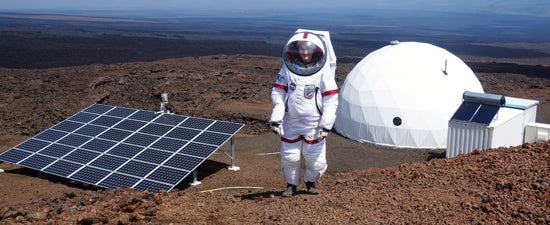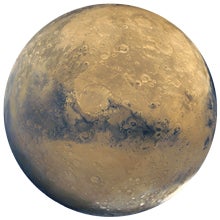The Martians
What would life on the Red Planet be like? A crew of six is halfway through a yearlong mission to find out how the technical and physical demands, limited resources, and sheer claustrophobia of living in a space habitat would affect human beings. Luckily, they’re better at this than you or I.

By Nicole Maranhas
To venture outside, they must wear spacesuits.
The red-rock volcanic landscape isn’t Mars, but for one year, Sheyna Gifford M.S. ’06 is living as if it is.
She is one of six scientists on the NASA-funded HI-SEAS (Hawaii Space Exploration Analog and Simulation) IV, a yearlong simulated Mars mission. Since last August, Gifford and her crewmates have been living in a solar-powered dome on the northern slope of Mauna Loa volcano in Hawaii to research how a crew in Mars conditions performs over time. Can they stay healthy, sane, happy? Can they remain a productive and cohesive unit on a remote desert that demands 24-7 peak performance, cohabitating month after month (and ultimately year after year) in less than 1,200 square feet of usable space?

Gifford and her crewmates have brought research projects—building a greenhouse, telemedicine—but here, they are mainly the experiments, wired with sensors that monitor everything from heart rate to how close they stand to each other. Every day, they complete questionnaires and surveys to measure their physical, mental, and emotional well-being. As Gifford writes on the blog she keeps about her time on simulated Mars, “people—not plants, propulsion or planetary weather—are the big X factor in space travel. In the known universe, people are the unknown.”
The crew is six self-described “space nerds” at the top of their fields, each selected for their unique set of skills. Along with Gifford, there is soil scientist Carmel Johnson, commander; astrobiologist Cyprien Verseux, crew biologist; physicist Christiane Heinicke, chief scientific officer; space architecture student Tristan Bassingthweighte, crew architect; and aerospace engineer and interplanetary flight controller Andrzej Steward, chief engineering officer. Gifford is chief medical officer and crew journalist, the culmination of nearly two decades of study: In addition to a master’s in biotechnology from URI, she has a doctor of medicine, a master’s in journalism, and is completing a master’s in business administration. In April 2015, she participated in the HERA (Human Exploration Research Analog) space simulation at Johnson Space Center before being selected for the HI-SEAS IV crew.
On her blog, Gifford writes of the moment she broke the news of her simulated Mars mission to her family, which includes a husband and two cats at home in St. Louis, Missouri. Friends weighed in on the prospect of her being stranded on a volcano for a year as a simulated astronaut: “That is so you.”
Home is now a two-story, white-vinyl dome. The main living space—work stations, kitchen and dining and fitness areas—is overlooked by a 400-square-foot loft with six compartments (i.e., bedrooms) that afford a sliver of privacy if you wear headphones. Every sound echoes: footsteps, cooking, and always the buzzing and breathing of machines. There are two small bathrooms with composting toilets and a biology lab that also serves as a medical bay, where several members of the crew cultivate plants and vegetables beneath LED lights. Food and tools are stored in the Sea Can, a 20-foot steel shipping container near the airlock, one of the few spaces that fills with sunlight in the middle of the day.
Down to each detail, they simulate the life of a future crew on Mars as closely as possible. They spend much of their days in cold and darkness. Their only connection to the outside is email, which operates on a 20-minute delay as it would on actual Mars. There is no Internet, although one of the crew downloaded the entire contents of Wikipedia onto a hard drive before his departure. For all that they miss (the feeling of rain and sunlight and wind on their faces, loved ones back home) there are light moments to hab life. Verseux plays the ukulele. Heinicke teaches the others salsa dancing. Gifford has made it her goal to learn Russian over the course of the year, partly in homage to her Russian-born grandfather, the great physicist Benjamin Bauer.
Every few weeks, a robot treks 8,000 feet up the volcano to deliver a resupply of dehydrated foods: beans, vegetables, fruit, flour, powdered milk, freeze-dried cheese. Gifford nurtures their sourdough starter (nicknamed Bob) and yogurt culture (Haans), keeping them watered and thriving, conserving energy by bringing Bob up to their bunks at night so that he may rise from body heat into a breakfast-ready loaf. “Even the most mundane tasks take a long time,” writes Gifford in an email. “If you want toast and yogurt for breakfast tomorrow, you need to start working on it right now. Up here, where it’s cold and we don’t have spare power for heat, the yogurt needs to be wrapped and put in a warm place. The next day, you can squeeze it through a cheesecloth and have breakfast. That’s the amount of thought and effort that the smallest meal of the day takes.” Without space to refrigerate or bake in bulk, everything is produced in small batches. “Just getting by is a big investment of time up here.”
To get by, they also rely on the water supply from two tanks on the volcano, which carry approximately 1,000 gallons of water and are resupplied every five to six weeks. At five gallons per day each, Gifford and crew live on a fraction of the average American’s daily water use, limiting themselves to one-and-a-half minute showers and reusing everything. Shower water is collected for washing clothes and mopping the floors; boiled water for rehydrating food gets a second life as soup broth. So far, shipping or generating even this amount of water for a crew of six living just one year on Mars would cost somewhere between $200- and $900-million.
Other challenges have been easier to overcome. For all earthly fears of powdered astronaut food, cooking in the dome has proven inventive and tasty. The crew makes crepes, tacos, quiches, chicken Marsala. For crewmate Heinicke’s birthday, they baked a chocolate chip cookie the size of a pizza.
Daily accomplishments bring perspective on how a Mars civilization might view life on Earth. “On simulated Mars, we dedicate an intense amount of time and energy to conserving water and power, to cultivating and growing food,” Gifford continues in email. “After living in a culture focused on those activities, it will likely be very challenging to live in a world that revolves around consumption. Imagine a person accustomed to checking the solar panel output before they so much as make coffee or flip a light switch being dropped into Times Square. That person isn’t going to see beauty. She or he is going to see excess, or at least, flagrant misdirection of resources.”

Suiting up takes practice. They begin prepping their spacesuits an hour before extravehicular activities (EVAs). Excursions are planned days in advance by the crew or assigned by mission control. The white EVA suits, which weigh nearly 50 pounds, are outfitted with cooling corsets to keep the crew members from overheating. Vision inside the helmets is limited, so they rely on radios to keep track of each other. Gifford brings with her a medical bag in case of slips or falls, one of the biggest dangers on the Mars-like desert. Before returning to the habitat, they wait out a five-minute recom-pression cycle in the airlock (on Mars, air pressure would be about 100 times thinner).
In the early afternoon, when the power supply is at its strongest—generated from 36 solar panels and stored in battery banks in the Sea Can—the crew makes use of the electricity for tasks such as washing clothes, cooking, or running on the treadmill beneath a porthole that looks out over the barren landscape. They keep healthy with yoga, P90X workouts, stationary bikes. There is a bar positioned across the doorway of the biology lab, by the bathroom; house rule is that you must do as many pull-ups as possible after using the toilet. As chief medical officer (callsign Dr. Mom), Gifford keeps a watchful eye on the crew’s well-being, monitoring their nutrition and exercise, imploring them to see her “early and often” with problems. On simulated Mars, the hospital is an hour helicopter ride away. On Mars, it will be a hundred million miles. Prevention is critical.
Gifford is reminded of this in December, when she performs her first medical procedure of the mission. Fortunately, it is a minor one—removing a wart on the foot of a crewmate. Still, it makes an impression. “When you have only a little bit of anesthetic, a limited number of needles…and your surgical site is the 7-by-8-foot biology lab, avoiding surgery is high on your list,” Gifford writes. It is part of her work on the mission to help future crews prepare for the worst. She runs safety drills with her crewmates, but the wart is a reminder that there are limits to what could be done on Mars. The emergency drills reveal challenges: lifting a coworker in a spacesuit onto a stretcher, for example. Dangers lurk both big—holes that open unexpectedly in the rocky ground—and not so small: warts, as Gifford points out in her blog, are actually benign tumors.
The procedure is successful, but its lesson is dire. She writes on her blog: “Since stepping into the role of Dr. Mars nearly four months ago, I’ve had a very sobering realization. In the future, out there in space, if the injury is serious, that person is probably not going to make it. Technology won’t be to blame, I wager. The availability of necessary supplies might be a limiting factor, but it won’t be as insurmountable as the availability of crew to care for that injured person. These missions are small. Each person is so vital that losing two individuals—the injured and the caregiver—would effectively paralyze many crews. Space—deep space—is for the healthy people to boldly go.”
We are a long way from Mars. In November, the crew reached their first quarter mark. Three months on simulated Mars brings a sense of gratitude, optimism about the research accomplished thus far, and anticipation of the remaining work to be done: the greenhouses, using robots to explore the subterraneous landscape. It also brings uncertainty, awareness that past simulated Mars crews on shorter missions have exper-ienced bouts of depression and listlessness by the halfway point.
And it brings, for those of us watching from afar, a dose of reality. Asked by a blog reader if she hopes to apply to the first manned mission to Mars, Gifford replies with humor: “If we surmount the mind-boggling number of barriers standing between us and a Mars mission—the human factors, the mechanical mysteries, the plant-based conundrums, the software gaps, the confounding fuel issues—if we weave evidence, trial-and-error and the fundamental laws of physics into a cloth that successfully covers the giant pile of nearly complete guesswork that is every first endeavor, and do this so successfully that we can have a Mars mission, I will rouse myself from my state of awe at the capaciousness of the human intellect and spirit long enough to sign up to go.”
Whether or not these 365 days lead to a Mars mission in their lifetime, Gifford and her crewmates will be part of that history. For Gifford, the boldest adventure has been to live by her personal motto: Make your life a story worth telling. •
Read more at hi-seas.org.
 Home
Home Browse
Browse Close
Close Events
Events Maps
Maps Email
Email Brightspace
Brightspace eCampus
eCampus


